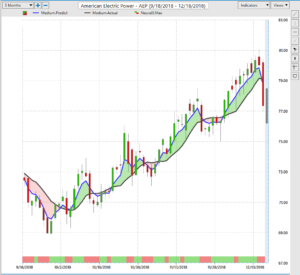
U.S. futures are pointing to a slight recovery for Wall Street with the stock market on pace for its worst December since the Great Depression. Aside from signs of slowing growth around the world, the drama is setting in as the FOMC begins its two-day meeting on interest rate policy. President Trump took aim again yesterday, stating it was “incredible that with a very strong dollar, virtually no inflation and the outside world blowing up around us… the Fed is even considering yet another rate hike.”
*Source: Seeking Alpha
Let’s consider American Electric Power Company (Ticker: AEP):

The VantagePoint platform recently indicated downside momentum.
Using the predictive indicators embedded within the VantagePoint platform and its predictive AI technology, we will point out three significant things. We have a bearish crossover indicated by the blue predictive indicator line crossing below the black simple moving average on December 17th. We can combine that with the VantagePoint propriety neural index indicator moving from the GREEN to the RED position on the same day. This indicator measures strength and weakness for a 48-hour period, in this case, weakness. The move to the RED position further makes the case for a potentially bearish scenario. We also have the predicted high and low below yesterday’s actual high and low indicating further weakness. I want to play the VP bearish indication.
Strategy Discussion
If you are strictly a stock trader, simply selling AEP in the $77.50 area is a prudent move. You are anticipating a move to the downside. It is always a good idea to enter a buy-stop order to mitigate potential losses. Placing that buy-stop in the $81.00 area will achieve that goal.
For active traders with a shorter investment time horizon, you can consider a setup utilizing options. Given the market conditions outlined above, taking an active, premium debit approach may be the best path to success.
Because of the reasons given above, the purchase of a debit put spread may be one way to approach this situation. First, you want to identify your target strike. To do this, you need three pieces of information: current underlying price, the date of the options expiration that you want to use and the implied volatility for that expiration. For AEP that yields a target strike of approximately $74. You can consider purchasing the January 18th regular monthly expiration 75/77.5 put spread for $0.90. The most you risk is the premium you pay and the most you can gain is the width of the spread less any premium paid. Max risk = $0.90, max reward = $1.60. This yields a risk to reward ratio of 1.78:1. This is a bit less r/r than we are used to but we have to consider that this is a utility company and they tend not to move very fast and we are buying an at-the-money spread that will start to profit with a very small move down.
Given the trading and market environment outlined above, a trader must evaluate whether this reward/risk ratio is appropriate for his/her risk tolerance.
If you would like to learn more about the VantagePoint platform and take advantage of the exclusive offer that our clients enjoy, please visit:



